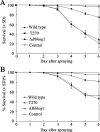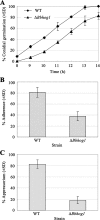Mitogen-activated protein kinase hog1 in the entomopathogenic fungus Beauveria bassiana regulates environmental stress responses and virulence to insects
- PMID: 19363067
- PMCID: PMC2687298
- DOI: 10.1128/AEM.01913-08
Mitogen-activated protein kinase hog1 in the entomopathogenic fungus Beauveria bassiana regulates environmental stress responses and virulence to insects
Abstract
Beauveria bassiana is an economically important insect-pathogenic fungus which is widely used as a biocontrol agent to control a variety of insect pests. However, its insecticide efficacy in the field is often influenced by adverse environmental factors. Thus, understanding the genetic regulatory processes involved in the response to environmental stress would facilitate engineering and production of a more efficient biocontrol agent. Here, a mitogen-activated protein kinase (MAPK)-encoding gene, Bbhog1, was isolated from B. bassiana and shown to encode a functional homolog of yeast HIGH-OSMOLARITY GLYCEROL 1 (HOG1). A Bbhog1 null mutation was generated in B. bassiana by targeted gene replacement, and the resulting mutants were more sensitive to hyperosmotic stress, high temperature, and oxidative stress than the wild-type controls. These results demonstrate the conserved function of HOG1 MAPKs in the regulation of abiotic stress responses. Interestingly, DeltaBbhog1 mutants exhibited greatly reduced pathogenicity, most likely due to a decrease in spore viability, a reduced ability to attach to insect cuticle, and a reduction in appressorium formation. The transcript levels of two hydrophobin-encoding genes, hyd1 and hyd2, were dramatically decreased in a DeltaBbhog1 mutant, suggesting that Bbhog1 may regulate the expression of the gene associated with hydrophobicity or adherence.
Figures






References
-
- Abbott, W. S. 1925. A method for computing the effectiveness of an insecticide. J. Econ. Entomol. 18:265-267.
-
- Altre, J. A., J. D. Vandenberg, and F. A. Cantone. 1999. Pathogenicity of Paecilomyces fumosoroseus isolates to diamondback moth, Plutella xylostella: correlation with spore size, germination speed, and attachment to cuticle. J. Invertebr. Pathol. 73:332-338. - PubMed
-
- Bölker, M. 1998. Sex and crime: heterotrimeric G proteins in fungal mating and pathogenesis. Fungal Genet. Biol. 25:143-156. - PubMed
-
- Boucias, D. G., and J. C. Pendland. 1991. Attachment of mycopathogens to cuticle, p. 101-127. In G. T. Cole and H. C. Hoch (ed.), The fungal spore and disease initiation in plants and animals. Plenum Press, New York, NY.
Publication types
MeSH terms
Substances
Associated data
- Actions
- Actions
- Actions
- Actions
- Actions
- Actions
LinkOut - more resources
Full Text Sources

